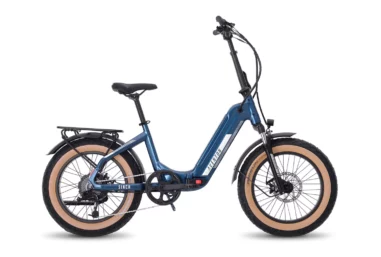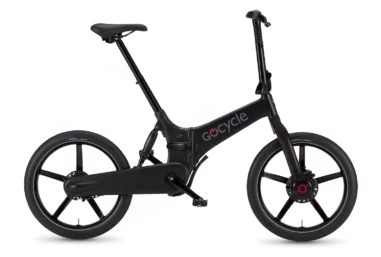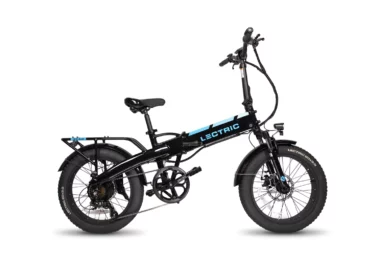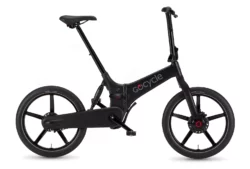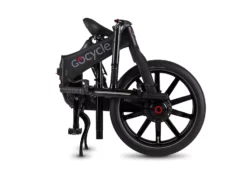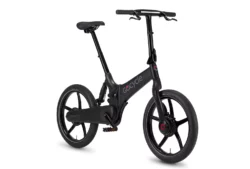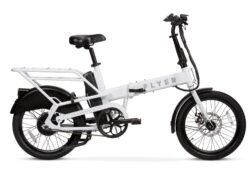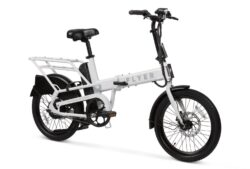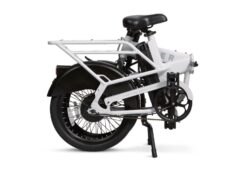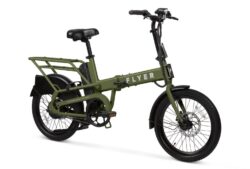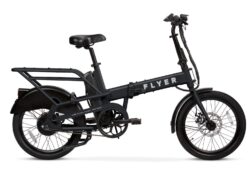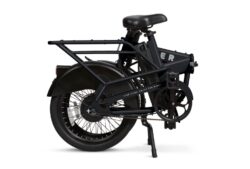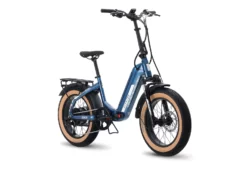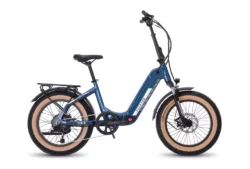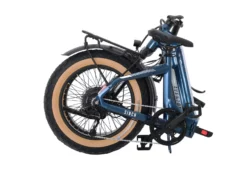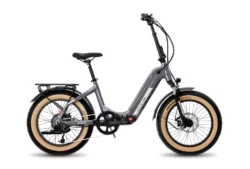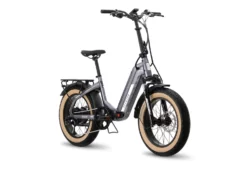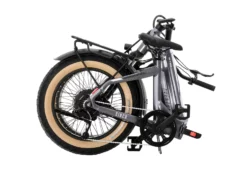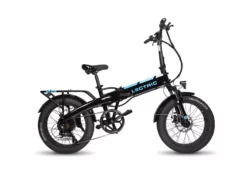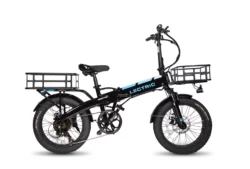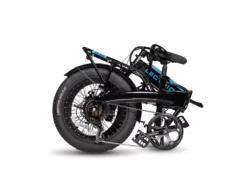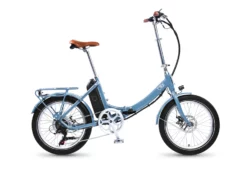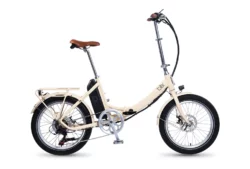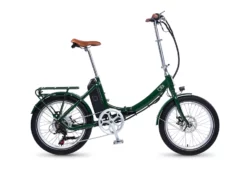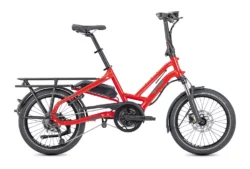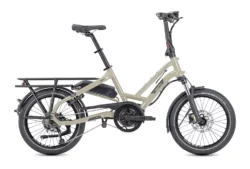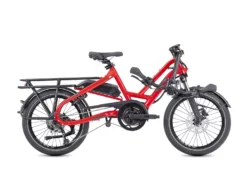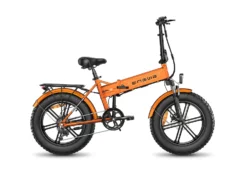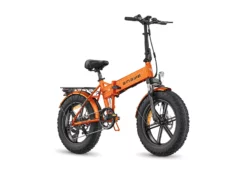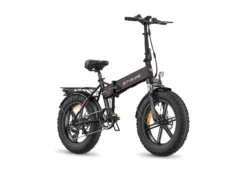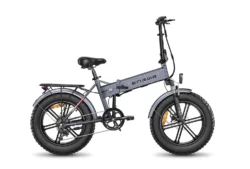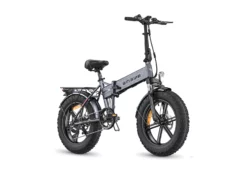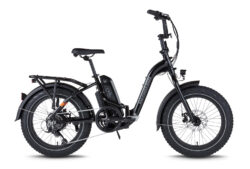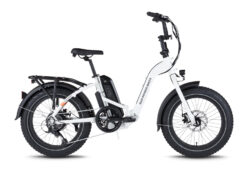How We Review E-Bikes
Our mission is to arm you with the most precise details, and we don’t just sit behind a desk – we hit the road (or trail) to put foldable e-bikes to the test. From hill climbs to range trials, our standardized evaluations yield unbiased performance data, shaping our universal 5-star scale.
In cases where a hands-on approach isn’t possible, our squad of seasoned e-bike researchers and true enthusiasts scours the web to provide you with the most dependable information possible.
Meet the experts behind our research and dive into our methodology for assessing foldable e-bikes.
Reviews of the Best Folding E-Bikes for Sale in 2024
Alright, enough dilly-dallying, let’s get back to business here – without any further ado, may we present: The best folding electric bikes for sale in 2024.
Let’s roll out…
- Best Overall Folding E-Bike: Gocycle G4i
- Best Folding Cargo: Flyer Folding Cargo E-Bike
- Best Folding Fat-Tire E-Bike: Aventon Sinch.2
- Best Budget Folding E-Bike: Lectric XP 3.0
- Best Folding Commuter E-Bike: Vika+ Flex
- Best Long-Range Folding E-Bike: Tern HSD P9
- Best Class 3 Folding E-Bike: Engwe EP-2 Pro
- Best Folding E-Bike for Seniors: Rad Rover RadExpand 5
Best Folding Electric Bike
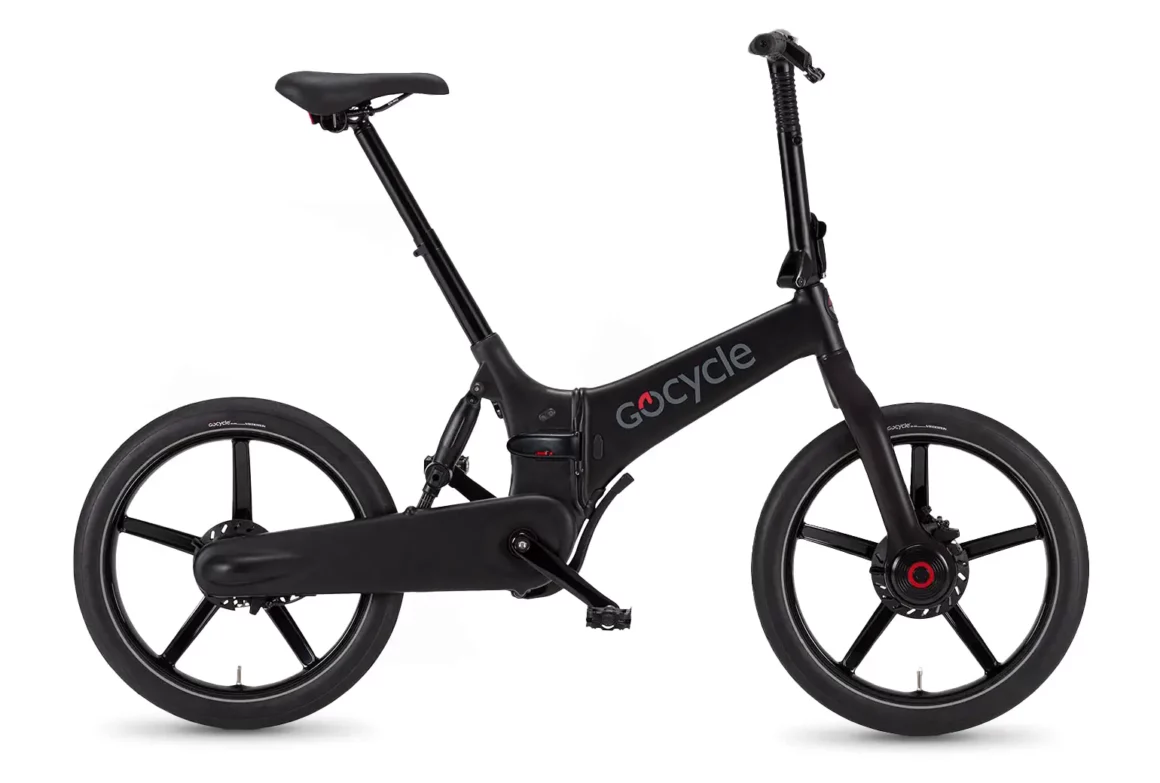
Gocycle G4i
What We Like
- Crafted with lightweight materials like carbon and magnesium provides a stylish appearance
- A feather-light weight of 37.7 lbs makes it easy to handle and carry
- The predictive automatic transmission system simplifies the riding experience
- Rolls on its wheels when folded
- User-friendly interface for customization to effortlessly adjust settings to your preferences
What We Don't Like
- When configured as a Class 1 e-bike without a throttle, the G4i may feel limiting to some
- No racks are included leaving the rider to shoulder the cargo while commuting
- The higher cost may discourage budget-conscious buyers
Overview of the Gocycle G4i
The Gocycle G4i is a lifestyle statement. This ultramodern folding e-bike is crafted from lightweight materials, including a carbon frame, aluminum fork, and magnesium rear, making it a feather-light 37.7 lbs, including the battery. The predictive automatic transmission system adds an element of simplicity, making it a breeze for riders of all levels.
The G4i is an ideal companion for those with limited storage space or a penchant for travel. Its ability to roll on its wheels when folded removes the hassle of carrying, and the sleek carbon monocoque frame ensures you ride in style. While lacking a standard rack, it’ll compensate for that with an integrated LCD screen and the Gocycle Connect app for super-easy customization.
Bottom Line
For the urban nomad or the commuter seeking a blend of elegance and functionality, the Gocycle G4i stands out. Despite its premium price, its innovative design, lightweight construction, and modern features make it a top choice for those ready to invest in a hassle-free and stylish folding e-bike.
Best Folding Electric Cargo Bike
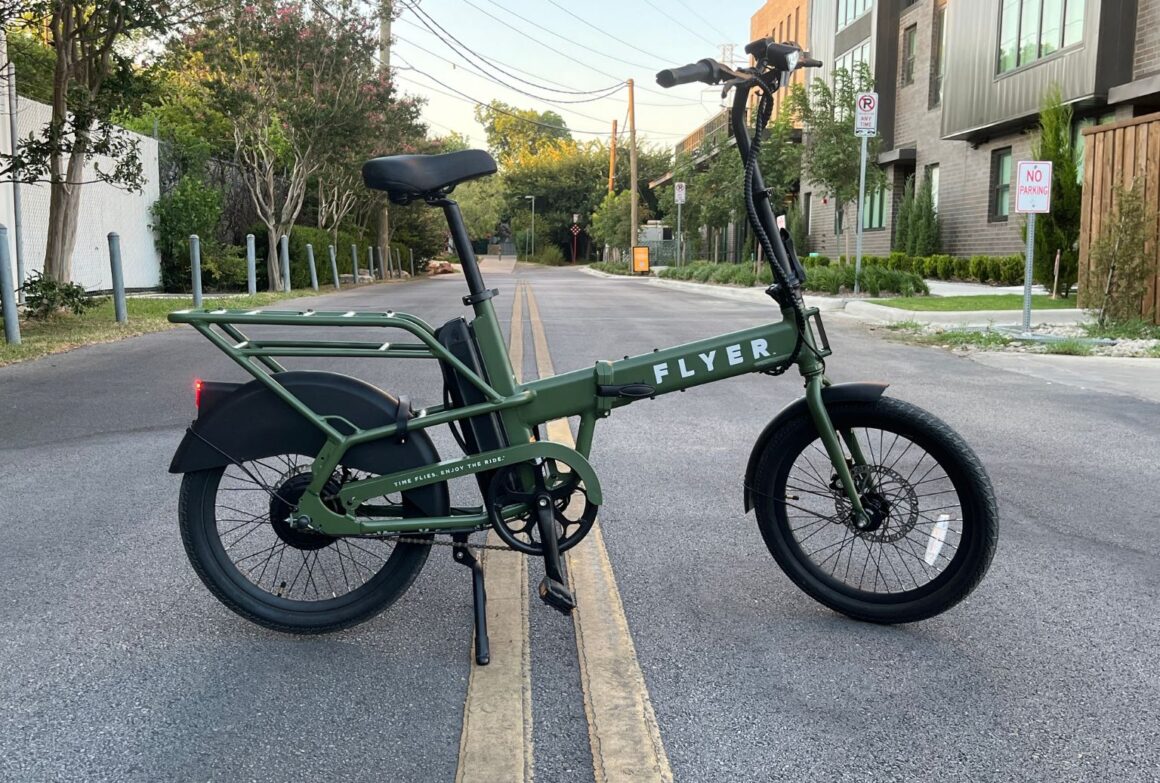
Flyer™ Folding Cargo E-Bike
What We Like
- Packs ample cargo space into a compact and foldable frame
- Rear rack is capable of carrying up to 80 lbs (great for taking the kiddos along)
- The aluminum frame is lightweight but strong, thanks to sturdy latches and a secure folding mechanism
- Telescoping stem and seat post to fit your height perfectly – 4’11” to 6’4”
- Integrated safety features, including a hooded rear fender and brake lights
What We Don't Like
- The absence of rear gears may pose challenges on steep hills
- Using higher pedal assist levels and carrying heavy loads will significantly reduce the bike's range
Overview of the Flyer Folding Cargo E-Bike
The Flyer Folding Cargo e-bike, born from the iconic Radio Flyer wagon company, surprises with its versatile and family-friendly design. Its compact foldable frame, sturdy construction, and thoughtful safety features make it a standout in utility e-bikes. While it may not conquer Everest-like inclines, it excels in urban landscapes and family adventures, offering a unique blend of convenience and adaptability.
Bottom Line
The Flyer Folding Cargo e-bike isn’t just a means of transport; it’s an invitation to a lifestyle of ease, flexibility, and sustainable mobility. Whether you’re a city dweller with storage constraints or a family looking to integrate cycling into your routine, this e-bike delivers on its promise of convenience and versatility. Unfold possibilities with the Flyer Folding Cargo E-Bike, where utility meets style, and every ride is functional and fun.
Lectric XP 3.0

The Lectric XP 3.0, while a commendable folding cargo e-bike, takes the runner-up position behind the Flyer Folding Cargo E-Bike due to certain trade-offs.
One notable factor is the weight, with the XP 3.0 weighing around 64 lbs for the standard range version. This weight, although reasonable given its affordability at $999, may pose challenges for users who need to carry it upstairs or during their commute.
Despite its robust 500W motor and customizable options, such as the passenger package or comfort bundle, the XP 3.0 lacks the exceptionally compact folding design of some competitors. However, with a generous payload capacity of 330 lbs, it remains a versatile choice for small-space living, RVing, camping, and utility runs.
Best Folding Fat-Tire Electric Bike
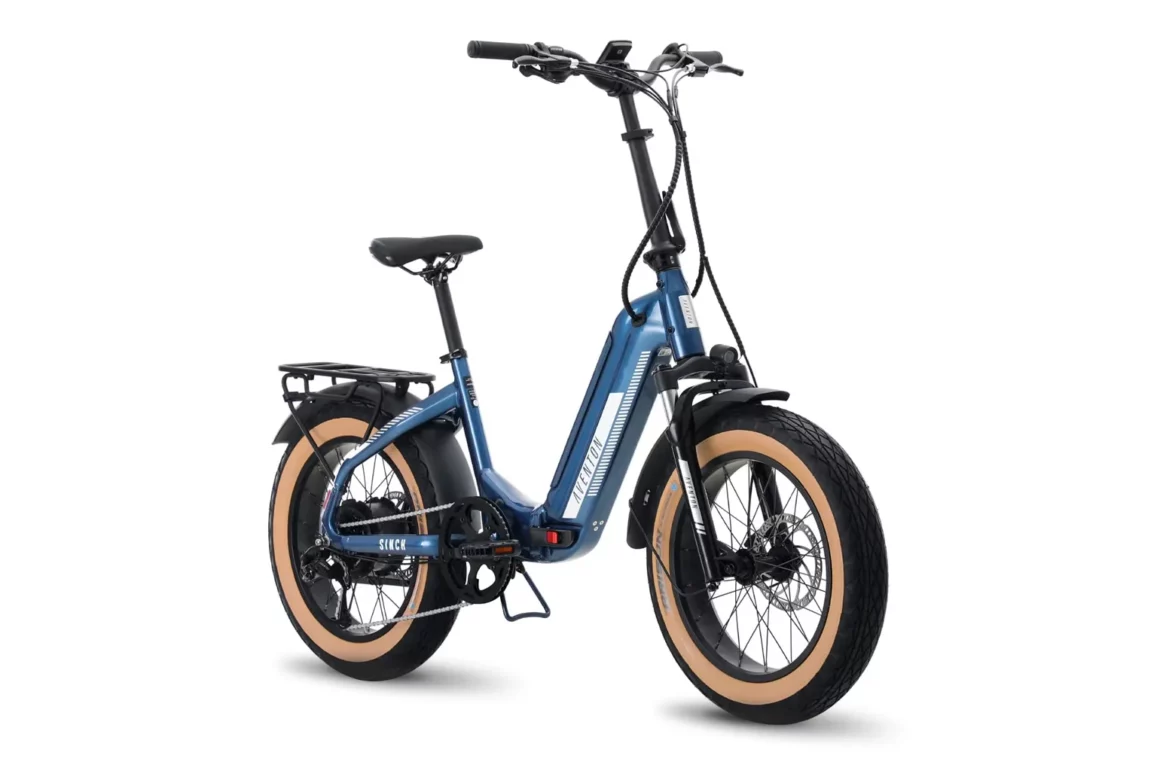
Aventon Sinch.2
What We Like
- 4” fat tires, robust front suspension, and torque sensor make off-roading a breeze
- Seamless assembly, folding ease, and compact design
- Backlit LCD, integrated lights with turn signals, and smart riding features for extra riding safety
- The step-through frame makes it super easy to mount and dismount
What We Don't Like
- Weighing in at 68 lbs, it's a bit hefty for a folding bike
- The right side of the handlebars is crowded, affecting overall comfort
- The latest models now feature a standard Aventon-branded shifter and derailleur, replacing the premium and well-known components used in earlier versions
Overview of the Flyer Folding Cargo E-Bike
The Aventon Sinch.2 stands out as a versatile and thrilling foldable e-bike, excelling in urban commutes and off-road adventures. Its robust motor, impressive range, and inclusive design make it a top choice if you’re looking for a dynamic and tech-savvy riding experience. While some comfort compromises and weight considerations exist, the Sinch.2 invites riders of all sizes to embrace a new era of e-biking.
Bottom Line
Priced at $1,299, the Aventon Sinch.2 is not just a folding e-bike; it’s an invitation to redefine your riding experience. From conquering city streets to tackling off-road trails, the Sinch.2 combines power, portability, and inclusivity. If you’re ready to trade the mundane for the extraordinary, unfold the possibilities with the Aventon Sinch.2.
Best Budget Folding Electric Bike
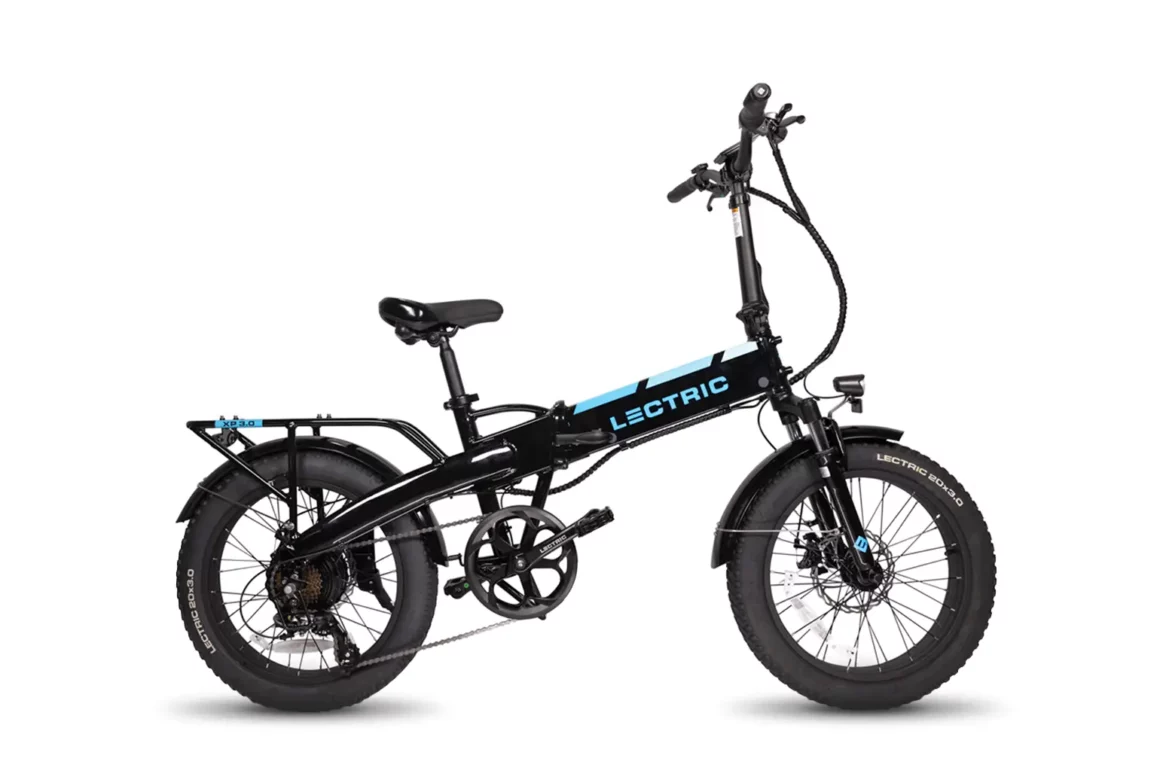
Lectric XP 3.0
What We Like
- Affordable price point for the budget-minded
- 500W motor with versatile Class options to suit all sorts of riding scenarios
- Numerous customization options for added comfort and utility
What We Don't Like
- It is relatively heavy at 64 lbs and might be a little tough to lift
- Limited comfort compared to full-sized e-bikes
Overview of the Lectric XP 3.0
The Lectric XP 3.0 is a budget-friendly folding electric bike that packs a punch. Its compact design and foldability make it a space-saving marvel, perfect for urban commuting or adventures on the go. With a 500W motor, this electric bike offers versatility with Class 1, 2, or 3 riding options, catering to different needs or local regulations. While it may be heavier than some counterparts, its affordability and customization options make it compelling.
Bottom Line
As a high-quality, affordable, and compact-folding electric bike, the Lectric XP 3.0 is an ideal choice for those navigating small living spaces, engaging in RVing, or embarking on camping adventures. Its compact yet sturdy wheels can handle various terrains, making it suitable for exploring hills near your campsite. If you’re constrained by space, this bike not only addresses the storage issue but also expands your possibilities with its impressive range.
Best Folding Commuter E-Bike

Vika+ Flex
What We Like
- Classic, throwback design (admit it, we all loved the 80s!)
- Folds down to a minuscule 36” x 21” x 28.5”
- Realistic 20-25 miles on throttle alone and potential for 30-35 miles with pedal assist
- 500W rear-hub motor to help conquer those inclines with ease
- Modular mounting system for a wide variety of racks and baskets
What We Don't Like
- The external cable routing may be distracting and maybe a bit distracting for some
- Suited primarily for road use and doesn’t like to eat dirt
Overview of the Blix Vika+ Flex
The Blix Vika+ Flex combines vintage charm with modern functionality, making it a unique choice for commuters seeking a classic aesthetic. Folding down to a compact size, it’s perfect for those with limited storage space or engaging in multimodal commuting. With a powerful 500W motor, reasonable range, and thoughtful design elements like disc brakes and modular mounting options, the Vika+ Flex brings vintage style into the 21st century.
Bottom Line
The Vika+ Flex is not just an e-bike; it’s a stylish statement with practical features. Whether you’re captivated by its 1980s-era folding bike vibe or seeking a commuter-friendly electric bike, the Vika+ Flex delivers on both style and performance. Embrace the fusion of vintage aesthetics and modern convenience with the Blix Vika+ Flex, where every ride becomes a nostalgic journey into the future of commuting.
Lectric XP Lite
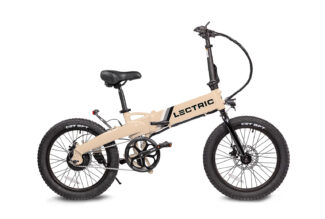
The Lectric XP Lite, though a commendable folding electric bike, lags behind the Vika+ Flex primarily due to certain limitations. One notable drawback is the absence of a pannier rack on the XP Lite, limiting its utility for riders seeking a practical commuting option for carrying shopping or other loads.
Additionally, the lack of gears on the XP Lite can pose challenges on hills, requiring you to adjust the motor power setting during pedal-assist use, potentially draining the battery more quickly in hilly terrains.
Despite these considerations, the XP Lite remains an attractive option for you if you prioritize a lightweight and fun-to-ride foldable e-bike. Its compact design, integrated lights, and external charging port excels in urban commuting, camping, and RVing scenarios, making it a versatile choice for riders who value agility and convenience.
Best Long-Range Folding E-Bike
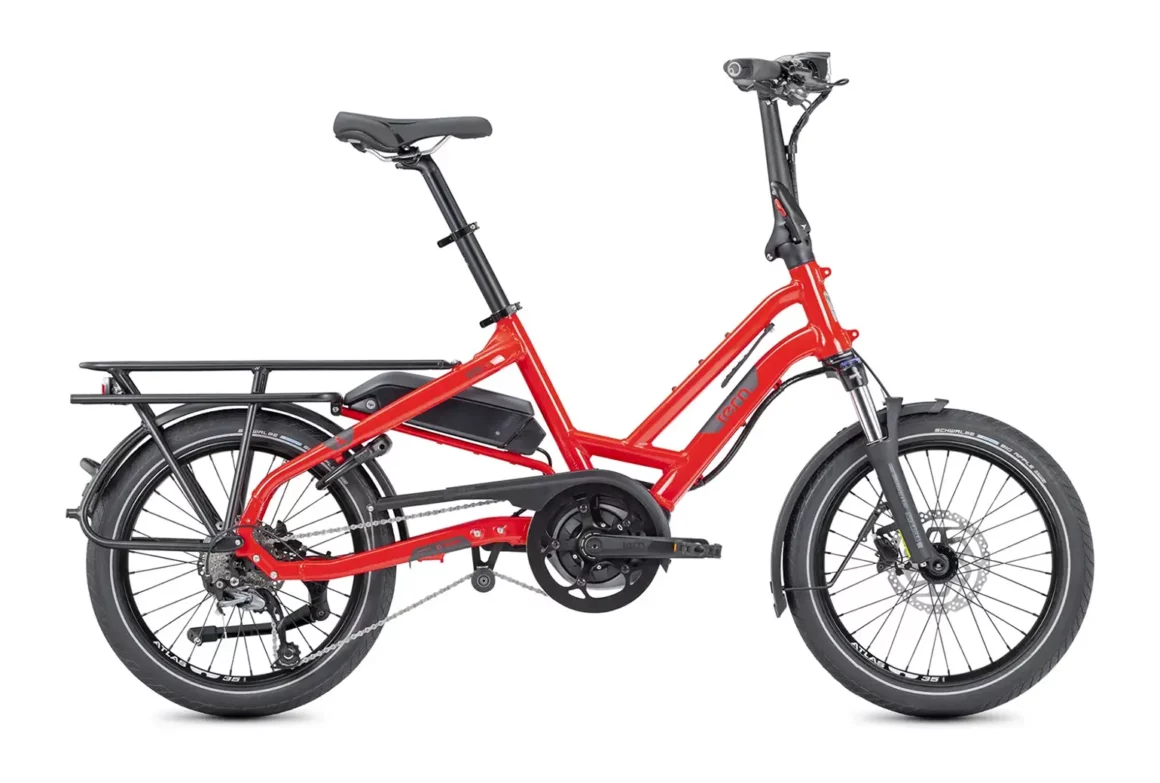
Tern HSD P9
What We Like
- Impressive battery life for extended urban journeys
- Cargo-friendly design for diverse business or personal use
- Neatly folds for storage in various compact spaces
- The rear rack supports up to 132 lbs
- Powerful Bosch Mid-Drive motor for efficient performance
What We Don't Like
- May be limited if used for busy downtown delivery operations
- Weighs 57 lbs, which may pose potential lifting challenges
Overview of the Tern HSD P9
Your reliable companion for urban adventures, the Tern HSD P9, seamlessly blending impressive functionality with a touch of style. Its compact design and folding capability not only conquers the city streets with a substantial 60-mile range but also neatly tucks away when not in use.
The robust cargo rack, capable of carrying up to 132 lbs, caters to business needs as well as everyday tasks, adding a layer of versatility that’s pretty hard to beat. Powered by the Bosch Active Line Plus mid-drive motor, this e-bike isn’t about just getting from point A to B; it’s about doing it with effortless flair.
Bottom Line
Picture this: a bustling cityscape, your to-do list a mile long, and the Tern HSD P9 beneath you. This e-bike isn’t just a mode of transport; it’s a game-changer. Need to breeze through crowded streets? Done. Planning an extensive day trip without worrying about recharging? No sweat.
The HSD P9 doesn’t just meet expectations; it exceeds them. From its cargo-friendly design to the convenience of folding after your ride, this e-bike adapts to your lifestyle. It’s your urban sidekick, ready for whatever the city throws at you.
Fiido L3 Long Range
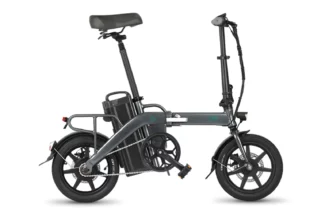
While the Fiido L3 Long Range offers a substantial range with its impressive 1,113 Wh battery and compact folding size, it falls slightly behind the Tern HSD P9 in certain aspects. The Fiido L3 Long Range has a motor cutoff at 16 mph and lacks a variable transmission, potentially impacting its performance on inclines compared to the Tern HSD P9.
Nevertheless, the Fiido L3 Long Range is a strong choice for its affordability, impressive battery capacity, and compact design.
Best Class 3 Folding Electric Bike
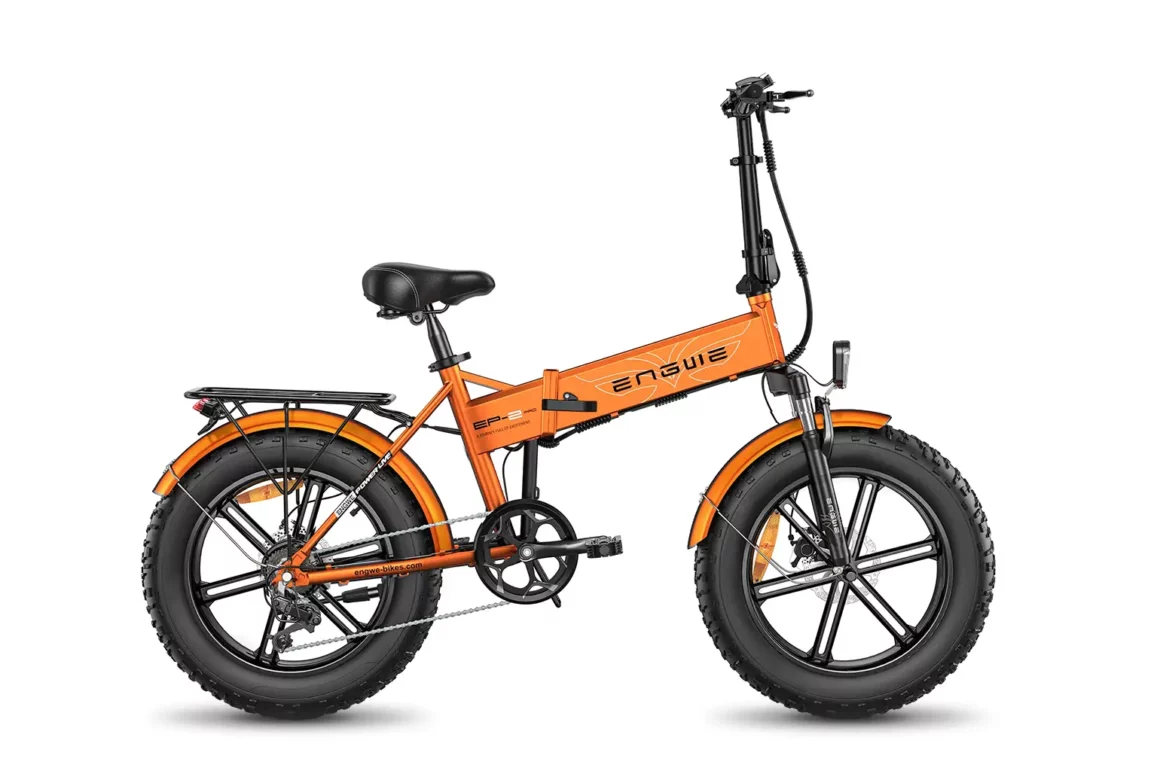
Engwe EP-2 Pro
What We Like
- Speedy 28 mph top speed for a swift commute
- Powerful 500W rear hub motor conquers challenging inclines
- LED lights, fenders, and bell enhance safety and visibility
- Affordable entry-level price without compromising quality
- The cruise control feature adds a touch of convenience
What We Don't Like
- Hefty 75 lbs weight may pose challenges for carrying onto public transport
- Lack of throttle might disappoint those desiring to rest their legs
Overview of the Engwe EP-2 Pro
The Engwe EP-2 Pro is a powerhouse of versatility and affordability. With a potent 500W rear hub motor, it can easily conquer those hills and handle most off-road adventures. The 50-mile range, cruise control, and folding capability make it a practical choice for various riders, from commuters to RV enthusiasts. LED lights, fenders, and a rack ensure a safe and convenient journey. While its hefty stature might be a drawback for some, the EP-2 Pro’s overall performance makes it an excellent choice for a class-3 folding e-bike.
Bottom Line
For those seeking a budget-friendly yet robust class 3 folding e-bike, the Engwe EP-2 Pro emerges as a top contender. Whether navigating city streets, conquering off-road trails, or coming along for the ride on your RV adventures, its versatile features and powerful performance make it an attractive choice. The EP-2 Pro is tailored to your lifestyle, all at an accessible price point.
Best Class 2 Folding Electric Bike
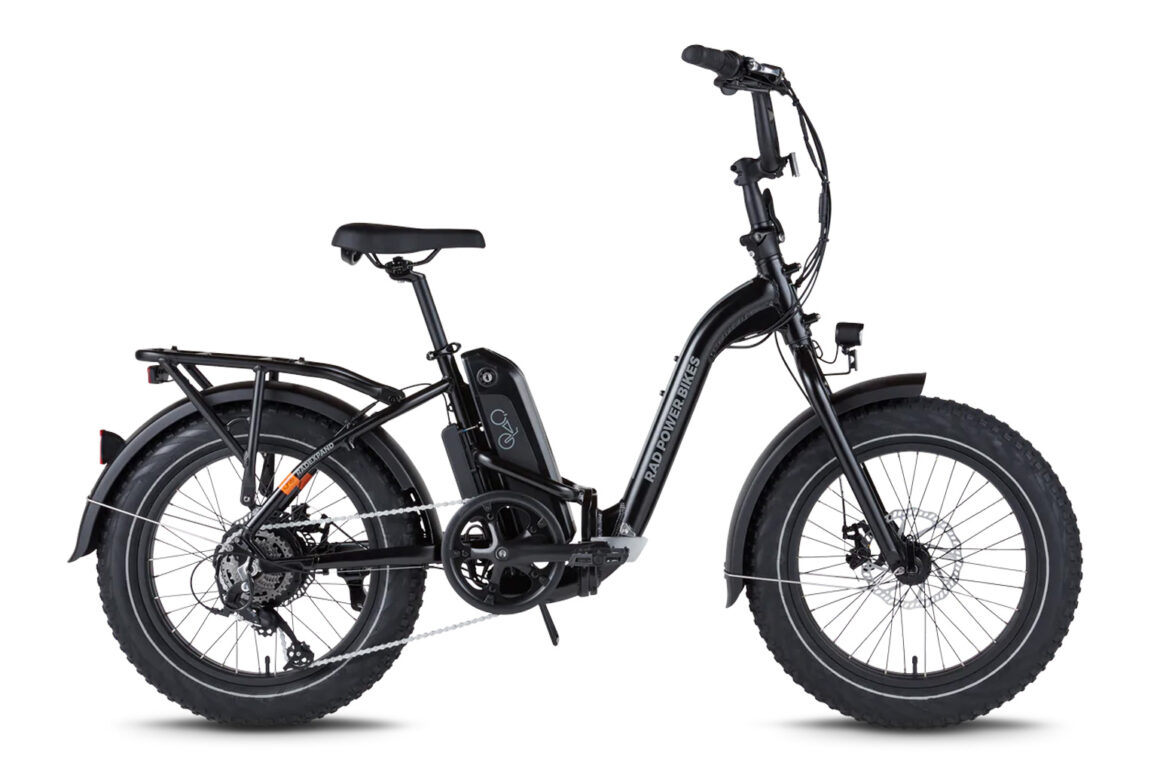
Rad Power RadExpand 5
What We Like
- A true off-road folding e-bike, featuring a 750W motor for powerful performance on hills and speeds up to 20 mph in both throttle and pedal-assist modes
- Despite its weight, the RadExpand 5 can be easily folded and stored in a car trunk or RV
- Has an upright city bike position, ergonomic rubber grips, and adjustable handlebars
- The inclusion of a standard pannier rack is a practical addition, allowing riders to use the bike for commuting with optional accessories
What We Don't Like
- The one-size-fits-all design limits the rider's height to 5'10", potentially excluding taller individuals from comfortably riding
- Weighing over 60 lbs, the RadExpand 5 may pose challenges for individuals needing to carry it upstairs or onto public transportation
Overview of the Rad Power RadExpand 5
The Rad Rover RadExpand 5 stands out as the optimal folding e-bike for older riders due to its thoughtful design that prioritizes comfort, stability, and versatility. The one-size-fits-all frame (up to a rider height of 5’10”) features an upright city-bike position and ensures a relaxed riding posture, ideal for seniors seeking an easy and enjoyable cycling experience. Including ergonomic rubber grips, adjustable handlebars, and a comfortable saddle further enhances the overall comfort and minimizes strain during long rides.
Its 4” fat tires play a big part in providing a smooth and comfortable journey by absorbing bumps in the road, offering a level of cushioning often missing in other folding e-bikes.
And for added utility, the RadExpand 5 includes a pannier rack as a standard feature. This thoughtful addition allows older riders to use the e-bike for commuting or errands, offering practicality and convenience in daily activities.
Bottom Line
The Rad Rover RadExpand 5 is the top choice for older riders seeking a blend of comfort, stability, and utility. Its design considerations, such as the upright position, ergonomic features, and accommodating tires, make it an excellent companion for seniors who prioritize a relaxed and enjoyable riding experience. The added convenience of a standard pannier rack ensures that this folding e-bike seamlessly integrates into the daily lives of older individuals, providing a versatile and reliable mode of transportation.
Lectric XP Step-Thru 3.0
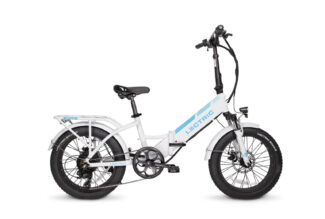
The Lectric XP Step-Thru 3.0, a commendable runner-up in the best folding e-bike for seniors category, showcases a compact yet powerful design. While it takes the backseat to the RadExpand 5, primarily due to its less robust build, it still emerges as a strong contender.
Boasting an impressive range of up to 65 miles and a zippy 28 mph speed, it offers a compelling blend of performance and convenience. The innovative inclusion of a passenger-carrying option adds a social dimension to your rides. However, its less powerful 500W rear hub motor might make it a struggle when tackling those longer uphill climbs.
Folding Electric Bikes 101
Before we go into the best folding e-bikes, let’s talk briefly about what we’re even discussing here. What do you say?
Say hello to the folding e-bike – the bike that bends to your will, literally! These two-wheeled wonders are like the Transformers of the biking world, folding up effortlessly for storage like a secret agent disappearing into the shadows. Need a bike that moonlights as a magician, disappearing into the hallway closet or chilling under your work desk? The folding e-bike’s got your back.
These foldable marvels are heroes for those tight on space or living on the move. They’re the perfect companions for RV adventurers, houseboat dwellers, or anyone rocking the “van life.” When it’s time to hit the road, just fold, stash, and roll out.
Transporting them is a breeze – hitch them onto a rack like a loyal sidekick, and you’re ready for your next escapade.
Nevertheless, these bikes redefine convenience, whether you’re tucking them into the back of your SUV or sliding them into a closet. They’re versatile, adapting to your storage needs without sacrificing too much of their electric prowess.
So, if you’re ready for a bike that folds faster than a poker player with a bad hand, the folding e-bike is your compadre.
FAQs About Folding Electric Bikes
Q: How Far Can a Foldable Electric Bike Go on a Single Charge?
A: That’s a bit like asking how many cookies you can eat in one sitting – it depends! Factors like the battery size, your weight (no judgment here), the terrain, and even weather shenanigans play a part. On average, a foldable e-bike can cover 20 to 60 miles on a charge. Pro tip: If you feel like conserving that sweet battery juice, throw in some pedal power with the electric boost.
Q: Can Foldable Electric Bikes Be Used in Inclement Weather?
A: Foldable e-bikes are usually up for some weather wrestling. Just make sure the tires are rated to withstand the weather you plan to ride in. Slippery roads? Pfft! Consider models with waterproof covers for the battery and controls, seal up those cables, and voila – raindrops, meet your match. But hey, if Mother Nature is going full-on drama queen, maybe consider giving your e-bike a day off at home. Because no one likes a rusty, grumpy bike.
Q: Are They Good for Hills and Off-Road Terrain?
A: Some models can be taken off-road, and some models will perform better than others on the hills. Check the specs, feel the vibes, and choose your two-wheeled adventure wisely!
Q: Are Foldable Electric Bikes Good for Older Riders?
Silver foxes rejoice! Foldable electric bikes are your trusty sidekick. Need a little oomph on those uphill battles? The motor will lend you a hand, making rides easier, even against the wind. Plus, they’re lighter than your average bike, making maneuvering a piece of cake (speaking of which, is anyone else craving cake?). It’s not just a mode of transport; it’s a mobility magic carpet!
What to Look for When Shopping for Folding Electric Bikes
Let’s dive into the must-know factors when on the hunt for your ideal folding e-bike. Here’s a handy guide to keep you on track:
Folding Features
- Handlebar Folding: Some e-bikes offer foldable or removable handlebars for convenient storage.
- Pedal Folding: Look for bikes with foldable or removable pedals, especially if storage space is a concern.
- Joints: Make sure that the joints where the bike folds are well constructed and secure.
Weight and Size
- A folding electric bike is indeed meant to be folded and carried or placed into a storage space. Some folding e-bikes are heavy, though, so if weight is a concern for you, point your eye at that weight to make sure you can handle picking up the bike.
- If you plan to carry your folding electric bike onto public transit, make sure you opt for a light bike. 45 lbs is a good top-end limit for somebody taking the train or bus.
- Look at where you will be storing your folding e-bike and make sure the bike can fit in its folded state. If you’re going to be transporting the bike in the trunk of your car, grab a tape measure and spec it out before shopping.
Quality Components
- Battery: This powerhouse is crucial. Determine whether it’s semi-integrated or fully integrated. Look for batteries made from reliable materials and subjected to safety testing.
- Display Screen: The informative hub of your e-bike. A clear, user-friendly display enhances your overall riding experience.
Motor
- Power Output: More watts mean more acceleration. But that can come at a cost of more weight, which might impact your ability to lift your bike.
- Torque: If you’re tackling hills, opt for a motor with higher torque, or larger gear ratio. It makes a significant difference in climbing and quick acceleration.
- Efficiency: A more efficient motor contributes to longer rides. Check for warranties to ensure the motor’s reliability.
Types of Assistance
- Pedal Assist: Power engages when you pedal. If your commute is a flat one, a Class 1 electric bike is a good fit for you.
- Throttle Assist: Throttle activation for a boost, but be aware of its efficiency. Check local regulations regarding legality.
- Combined Assist: Enjoy the benefits of pedal and throttle assistance based on your preference and terrain.
Tires
- Consider the terrain: Choose tires that match your riding needs. Wider knobby tires will usually provide more stability and confidence on various surfaces.
- Commuters: Look for semi-wide tires with a smoother tread for smooth rolling on city streets.
- Utility riders: Look for wider knobbier tires with a good grip for some off-road riding.
Safety Certification
- Prioritize safety! Ensure your chosen bike meets the necessary safety standards for your region. A quick online check or inquiry with the seller can reveal the certifications. Look for UL Safety Certifications to ensure that all the electronics pass the highest standards.
Budget Considerations
- Set your budget wisely. Folding e-bikes come in various price ranges. Consider it an investment in your transportation needs. Sometimes a bigger investment up front will last you longer than a cheap purchase that you need to replace sooner.
In the end, the choice is yours to make. Only you can determine what matters most to you. Consider the above factors, and seize the foldable electric bike of your dreams!
Keep those wheels turning!
Guides to Help You Learn More
Craving more information? Need to answer some of those burning questions? We get it, there’s a lot to learn when it comes to electric bikes. But, fear not, we’ve got you covered. Check out these resources we think you will find helpful:


